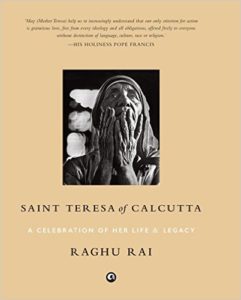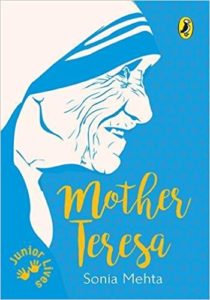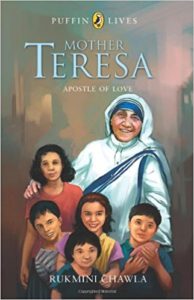Saint Teresa
 Saint Teresa or Mother Teresa (as she was known till 4 September 2016) and her Missionaries of Charity are known for their care of the poor and establishment of hospices worldwide. Many considered her to be a living saint in her lifetime and after her death miracles were attributed to her. By the time she died in September 1997 her Missionaries of Charity had 610 missions spread across 123 countries.
Saint Teresa or Mother Teresa (as she was known till 4 September 2016) and her Missionaries of Charity are known for their care of the poor and establishment of hospices worldwide. Many considered her to be a living saint in her lifetime and after her death miracles were attributed to her. By the time she died in September 1997 her Missionaries of Charity had 610 missions spread across 123 countries.
There are plenty of books written about Saint Teresa. The first is Saint  Teresa of Calcutta: A Celebration of her Life & Legacy , a beautiful collection of photographs by Raghu Rai. He has an impressive collection of pictures taken while he would shadow her at work and some of her canonisation ceremony in Rome. The few anecdotes he shares of his interactions with her confirm her gentle, charitable nature and her overwhelming desire to do good by people especially those who are suffering. There is a particularly revelatory episode he shares about casteism and caregiving.
Teresa of Calcutta: A Celebration of her Life & Legacy , a beautiful collection of photographs by Raghu Rai. He has an impressive collection of pictures taken while he would shadow her at work and some of her canonisation ceremony in Rome. The few anecdotes he shares of his interactions with her confirm her gentle, charitable nature and her overwhelming desire to do good by people especially those who are suffering. There is a particularly revelatory episode he shares about casteism and caregiving.
Her love was for humanity and was not limited to any one faith, which was why some of her detractors, who accused her of using her work to convert people, did not make much of an impression on the many millions who were utterly devoted to her. It did not matter to her if you were a Christian, Hindu, Muslim, Buddhist, Sikh, Jain, believer, agnostic, atheist or Communist — she treated everyone equally. She loved those who needed her without the slightest regard to creed or caste. I am reminded here of an incident that illustrates this aspect of life. Mother’s credo was that she was not a special worker but a mother who took care of all those who needed her. Once, an old Brahmin lady was dying on the streets of Calcutta. The sisters of the Missionaries of Charity wanted to pick her up and bring her to their home for the aged. The woman, however, insisted that she couldn’t be touched by anyone but a Brahmin. When Mother heard about this, she decided she would personally minister unto the woman. As she was about to touch her, the dying woman asked her if she was a Brahmin. While recounting the episode, Mother said she asked herself: ‘Who is a Brahmin?’, to which she felt that anyone who served His people was a good Brahmin, and so she said to the dying woman, ‘Yes, I’m a Brahmin.’ And she picked her up and brought her home.
This anecdote illustrates beautifully her focus on caregiving while ensuring the patient has a dignified closure to their life. It was this generosity of spirit and kindness which enabled her to set up missions around the world. Everywhere she went she was welcomed. Sure she had her fair share of critics. She was accused of siphoning of funds. She was accused of conversions. She was accused of not really investing in improving the health of the people she brought in but focused her energies on tending to them till their death. The fact is she and her sisters of charity offer a social service for the marginalised and the poor, many of whom are shunned by their families and society. This is a stunning photobook from a photographer who in a sense is not only paying his respects to a beloved subject and mentor but is also making a crucial contribution to history by publicising some of the rare images he was privileged to take. Photography by its very art form can be intrusive and disruptive, yet there is an almost magical quality to the images included in the book as if the subject and photographer had a special relationship.
 Conferring the sainthood on Mother Teresa is possibly the reason why Puffin India has launched their new series, Junior Lives, with a biography of Saint Teresa — Mother Teresa. Junior Lives is a version of the successful Puffin Lives series meant for older children. Junior Lives is meant to be a series of illustrated books created for young readers ( 8+) to acquaint them with world heroes. Unfortunately despite all good intentions at heart the inaugural title of Junior Lives fails to live up to expectations. Beginning with the book title itself launched eight months after sainthood has been conferred by the Pope — how can it continue to be termed as Mother Teresa, why not Saint Teresa? Terminologies have to keep pace with historical changes. Secondly even if this book is meant for younger readers why
Conferring the sainthood on Mother Teresa is possibly the reason why Puffin India has launched their new series, Junior Lives, with a biography of Saint Teresa — Mother Teresa. Junior Lives is a version of the successful Puffin Lives series meant for older children. Junior Lives is meant to be a series of illustrated books created for young readers ( 8+) to acquaint them with world heroes. Unfortunately despite all good intentions at heart the inaugural title of Junior Lives fails to live up to expectations. Beginning with the book title itself launched eight months after sainthood has been conferred by the Pope — how can it continue to be termed as Mother Teresa, why not Saint Teresa? Terminologies have to keep pace with historical changes. Secondly even if this book is meant for younger readers why  are facts not spelled out clearly rather than diluted as with the following passage (Chapter 8):
are facts not spelled out clearly rather than diluted as with the following passage (Chapter 8):
There are many other examples of how Mother Teresa came to help during a dangerous crisis. In 1984, in Bhopal in India, a large company that manufactured pesticides made a terrible mistake. A dangerous gas leaked out from the factory at night and killed thousands of people. …[Mother Teresa helped raise funds and take care of the injured].
Why is Union Carbide as the offending company not mentioned clearly? By soft-pedalling the monstrous manmade Bhopal Gas Tragedy and terming it as a “terrible mistake” by way of an explanation to children is wrong. Children tend to see the world in black and white so why not tell them the truth? Share facts. Not judgements. By swiftly rearranging historical narrative in this manner will contribute in the creation of a new generation who won’t in future see the gas tragedy for the horror it was. This is the converse of what children are taught early that just as every action has an equal and opposite reaction so must children learn that every action of theirs has a consequence and they must behave responsibly. Even if it is a biography about Mother Teresa this passage implies that it was an accident and the corporation is not really to blame but don’t worry a charitable soul like Mother Teresa is ever present to tend to the needy. It is teaching an unforgiveable lesson that mistakes happen and people directly responsible for it are not necessarily to be blamed instead there will be others to pick up the pieces.
Another example of poor writing and editing is a few lines later when she travelled “she went to a country called Ethiopia“. Feeling the need to describe Ethiopia as a country especially when Italy, America, Germany and Switzerland were not qualified in a similar fashion in Chapter 7 is cringe-worthy. This smacks of a cultural prejudice that is inadvertantly being passed on to the next generation and at a time when racial diversity and inclusiveness are the buzz words. It is ironical that such unforgiveable errors have been permitted in a biography of a woman who was loved by millions around the world, irrespective of their caste, colour or creed.
Texts for children are to be put together with great deal of care and thought. Every little aspect needs to be taken into account and anticipated. Young readers tend to engage with the text minutely and every little element in it — whether text or illustration — is scrutinised, queried and discussed threadbare before being imbibed and becoming a critical part of their mental furniture. One can only hope that the future titles meant in this series are created with due care.
Raghu Rai Saint Teresa of Calcutta Aleph Book Company, 2017. Hb. Rs 1499
Sonia Mehta Mother Teresa Puffin Books, Penguin Random House, India, 2017. Pb. Rs 150
11 May 2017
